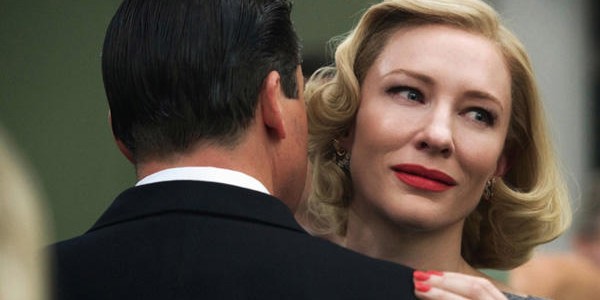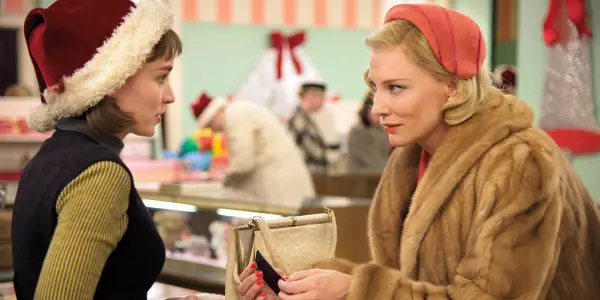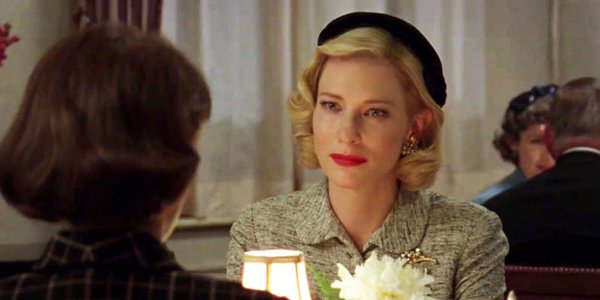CAROL: An Emotionally Affecting & Gorgeously Crafted Masterpiece

Alistair is a 25 year old writer based in Cambridge.…
Most directors have a recognisable style that characterises their movies, giving them a distinctive visual stamp that claims it as wholly theirs. Todd Haynes is an unusual director in that his style differs from movie to movie, fully committing to replicating different genres and bygone fashions to the extent that he has no distinctive visual style that claims any movie as distinctively his.
With Carol, he has made a period drama not entirely dissimilar from his early film, 2002’s Far From Heaven.
A Modern Take on a Classic Period Drama
However, Far From Heaven fully committed to replicating the style of Douglas Sirk melodramas, adding thematic content the Hays code that dominated Hollywood productions in the 50’s wouldn’t allow. Carol appears to be an updating of the “woman’s film”, but without the melodramatic connotations of its leading directors. Women’s films in general were melodramas depicting domestic life and romantic entanglements, centred on female leads. In modern cinema, when films can only get financed if there is a male lead alongside the actresses, the fact a film that harks back to that tradition can get made is a miracle in itself.
Carol is merely a simple 50’s set romantic drama. Over the course of the Christmas season, shop worker Therese (Rooney Mara) meets a customer named Carol (Cate Blanchett). Carol leaves her gloves on the checkout desk, leading Therese to return them to her and start a fast-burning affection. The problem is Carol has baggage, currently in the midst of a messy custody battle with her husband Harge (Kyle Chandler), whilst Therese is being held hostage by her own needy would-be suitor who proposes marriage every time he becomes aware of her lack of romantic interest.

Carol is an adaptation of Patricia Highsmith’s 1952 novel The Price of Salt, originally published under a pseudonym due to the then-controversial subject of homosexuality. LGBT themes are commonplace in Haynes’ films, but what is most remarkable is the fact the sexuality of the characters is never an issue. The words “homosexual” and “lesbian” are never once uttered, presumably a reference to the fact that the word “homosexual” was never used in a film until 1961’s Victim, which was subsequently banned in the UK and US because of it.
This isn’t to say Carol is a film that is closeted about the sexuality of its characters, it’s one that recognises the affection they grow to share and doesn’t want to undermine that by pigeonholing them on the specific nature of their sexuality. The world around the characters may be cynical towards their love, but Haynes tells the story from a thoroughly modern perspective, rendering every little detail either beautifully intimate or quietly heartbreaking without the need to over-contextualise life for LGBT people during the period.
Carol has some of the most lavish period detail I’ve ever seen in cinema, doing for the 50’s in two hours what Mad Men did for the 60’s over the course of seven seasons. The intoxicating design is all the more remarkable due to the fact that Haynes shot the film mostly on location in Cincinnati, a city that has largely been left unchanged since the decade, making it the perfect stand in for mid 20th century New York. The reason the movie feels masterfully out of time isn’t solely due to period detail, with equal credit to be given towards the perfectly calibrated performances; Cate Blanchett plays the role of Carol in an understated way that still recalls the sass of 50’s woman’s picture idols.
Seductive and Never Exploitative
In recent years, Blanchett has become increasingly reminiscent of a faded matinee idol; although inspired by Blanche from A Streetcar Named Desire in her Oscar winning Blue Jasmine performance, there was more than a hint of Sunset Boulevard’s Norma Desmond in her failure to grasp the reality around her.

When Therese first catches her eye with Carol’s, possibly the most beautiful love at first sight sequence in cinema, it’s like she is coming face-to-face with a larger than life screen beauty for the first time, one who still has an air of glamour, just one that has been tinged with years of hardships and regret. As with many of the sequences in this film, it is the most affecting when it leaves its underlying emotions unsaid due to the characters’ full awareness they are living in a repressed society. When they express affection, it feels like an emotional gut punch, so accustomed we are becoming to seeing them holding back the full extent of their feelings.
There is one sequence that stops Carol from fully subscribing to the Hays code convention. For the majority of the first half, when sexuality is cloaked under euphemisms and could be interpreted as nothing more than a close friendship, it resembles the 1958 film adaptation of male gaze” overshadowing proceedings, rendering the scene genuinely affectionate as opposed to cheaply pornographic.
It is an intimate moment as far removed from the extensive sex sequence in Blue is the Warmest Color. That movie was criticised by the author of its source material for conforming her intimate work to be nothing more than porn, informed solely by the straight male director’s clear familiarity with lesbian sex solely through videos accessed through incognito windows.

Rooney Mara’s performance in comparison with Blanchett’s is a work of quiet wonder. If Carol is talkative and sultry in a down to earth (yet not quite of it) fashion, Mara is essentially the audience surrogate; the grounded person afraid to be upfront about her romantic desires, who becomes slowly infatuated with somebody for what we are led to assume is the first time. It is an incredibly human performance that feels enormously relatable – who hasn’t felt an all-consuming, borderline obsessive infatuation with somebody you perceive to be out of your league, ignoring all the baggage in their life solely for a chance to be with them?
Conclusion
In its quiet, understated way, Carol is one of the most emotionally affecting films of recent years. A film for anybody who has ever fallen in and out of love, dealing with hopeless infatuation and the slow transition to the messy reality that all but threatens to burn out the initial spark, Carol is more than just a gorgeously crafted period piece. It is a masterpiece of the highest order.
As awards season creeps into view, which movies have the best chance of going all the way to the Oscars?
Carol is out now in the US, with a UK release to follow on November 27. All international release dates can be found here.
Does content like this matter to you?
Become a Member and support film journalism. Unlock access to all of Film Inquiry`s great articles. Join a community of like-minded readers who are passionate about cinema - get access to our private members Network, give back to independent filmmakers, and more.
Alistair is a 25 year old writer based in Cambridge. He has been writing about film since the start of 2014, and in addition to Film Inquiry, regularly contributes to Gay Essential and The Digital Fix, with additional bylines in Film Stories, the BFI and Vague Visages. Because of his work for Film Inquiry, he is a recognised member of GALECA, the Gay & Lesbian Entertainment Critics' Association.













